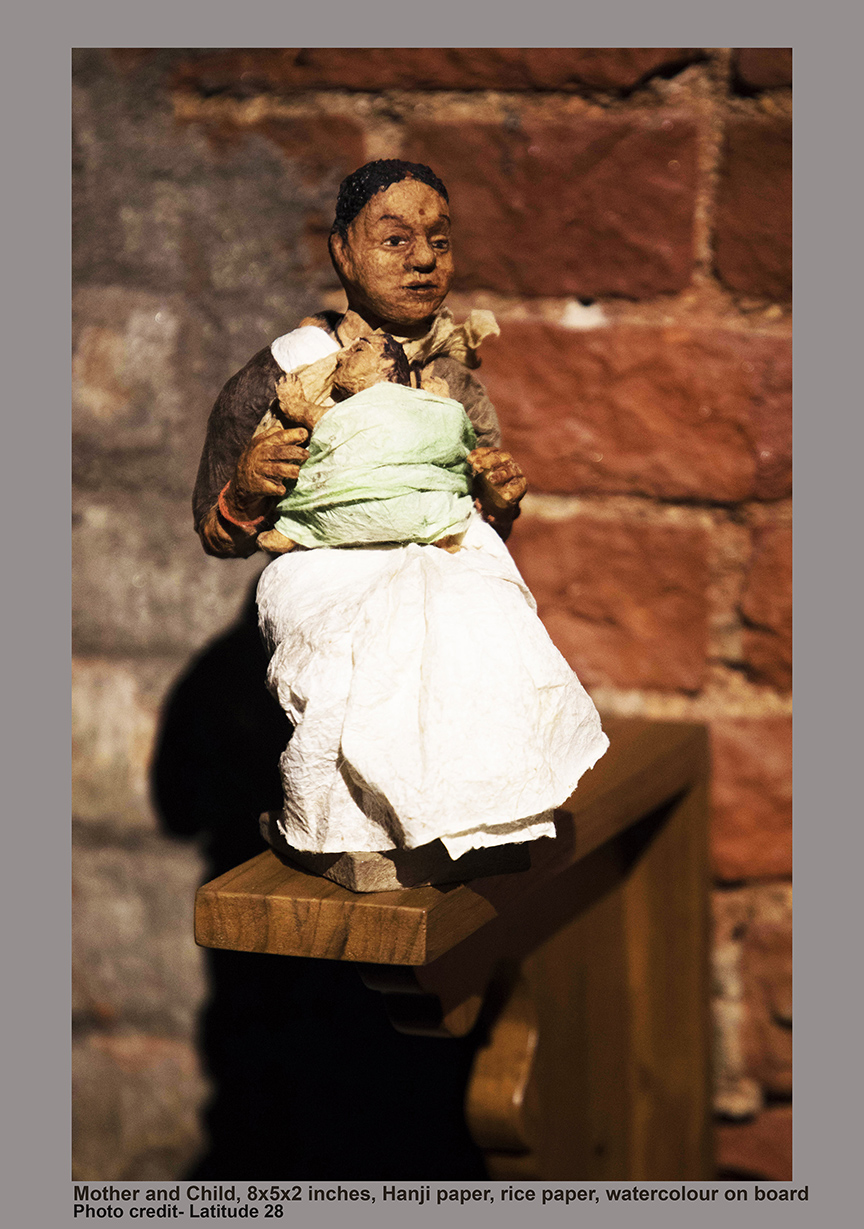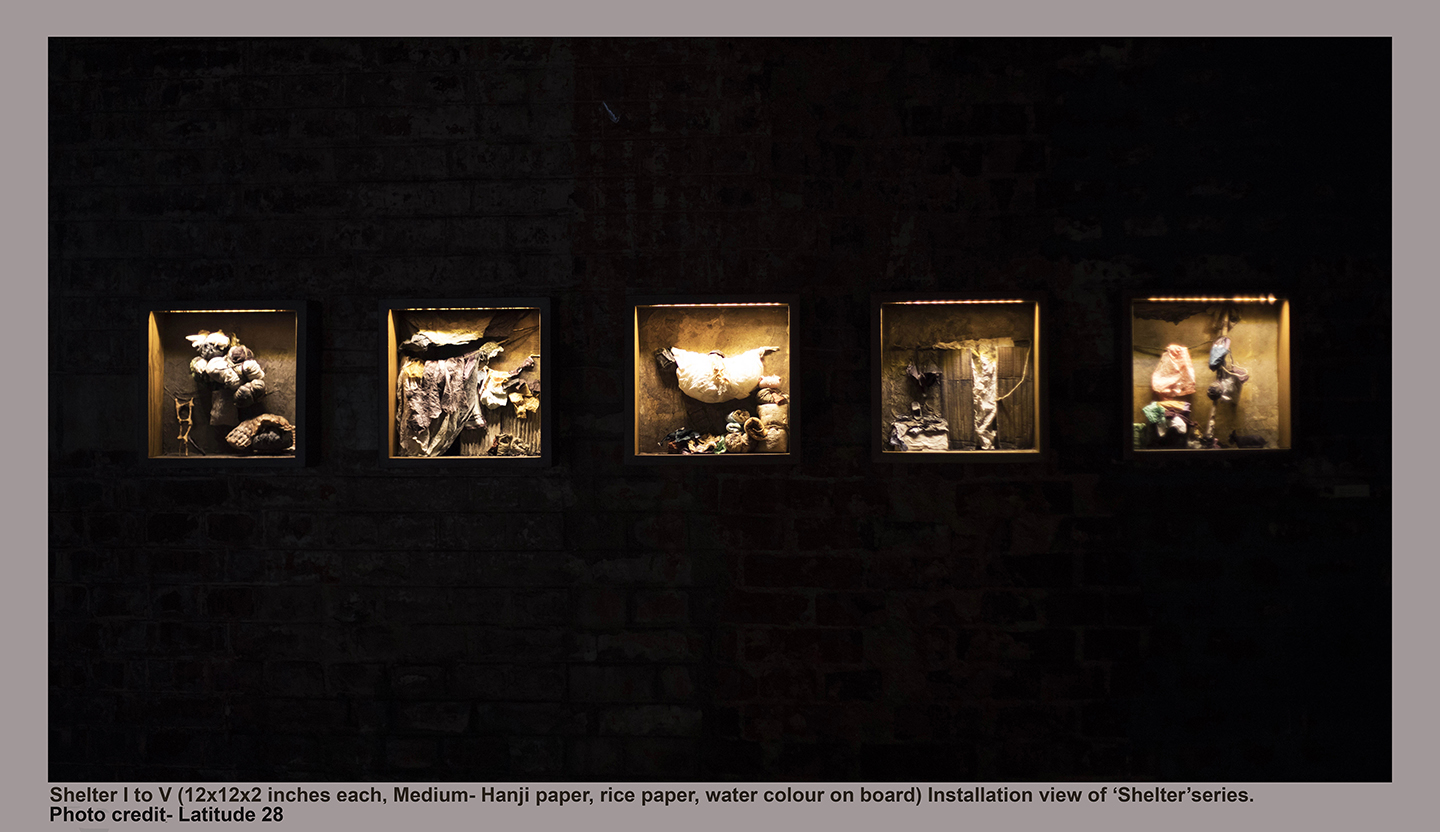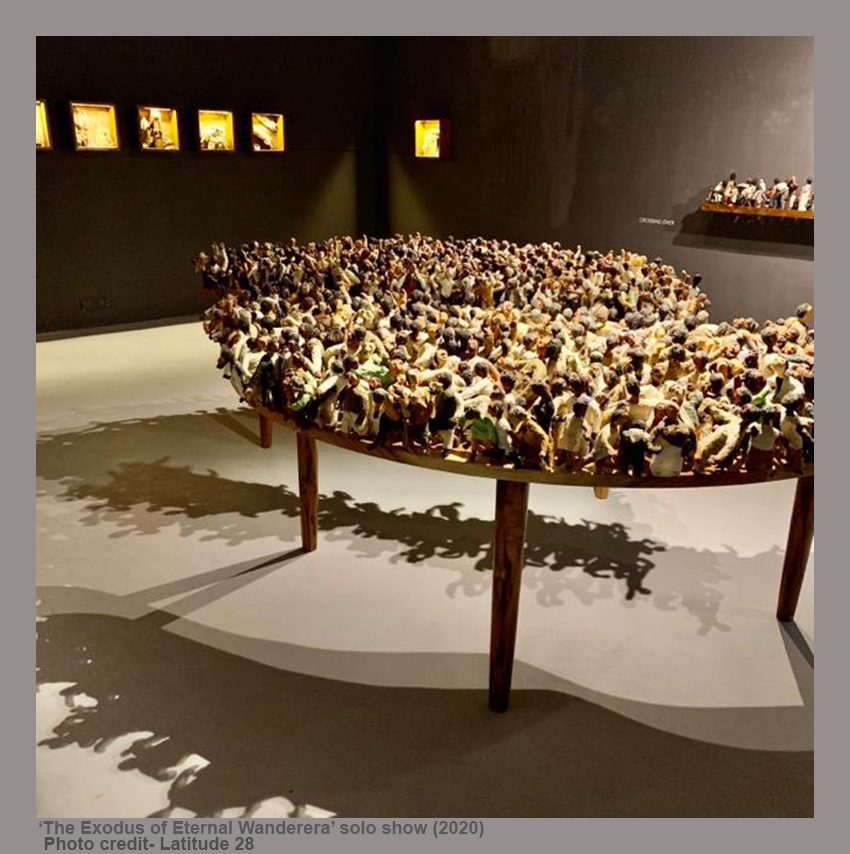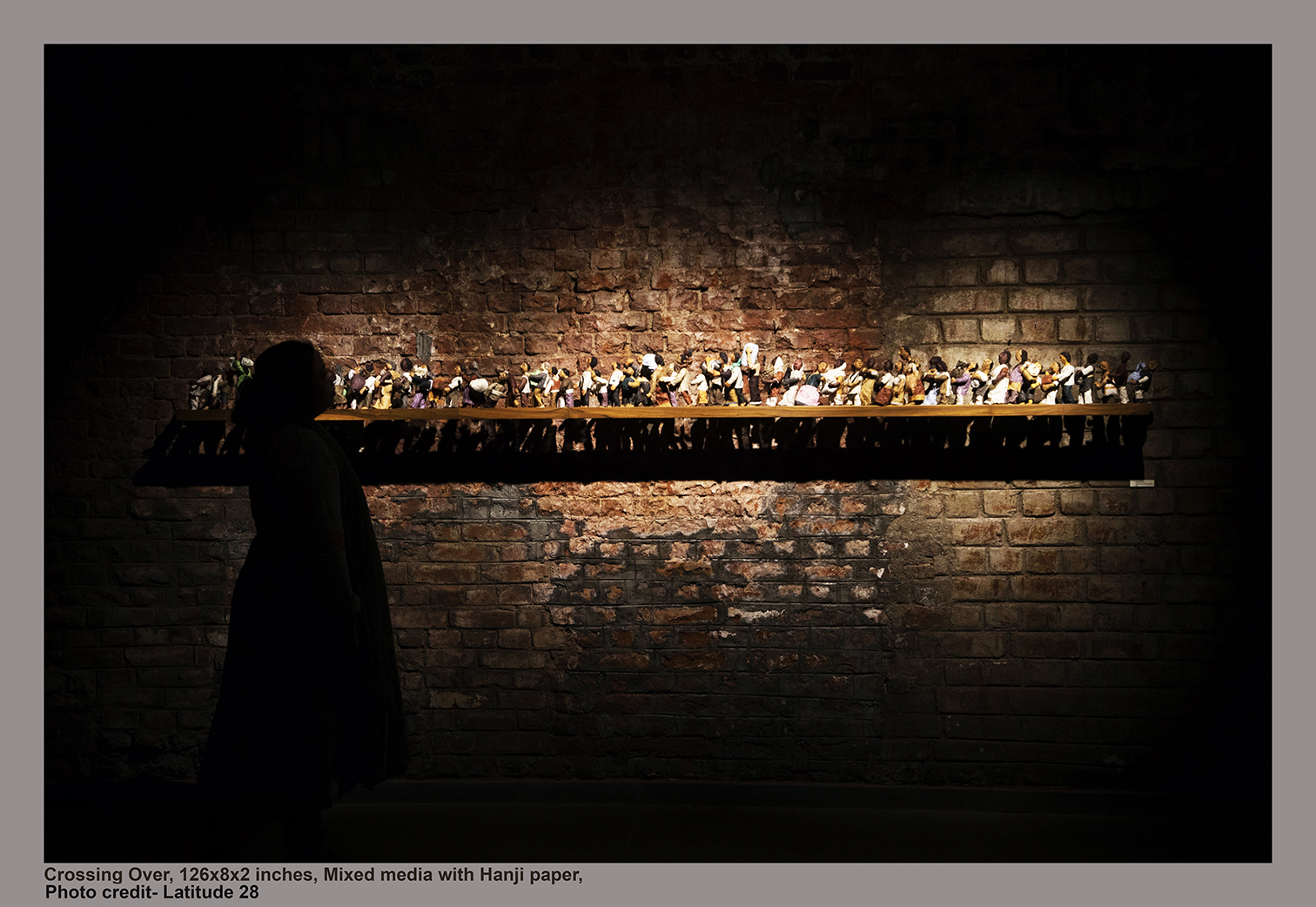Indian contemporary artist Sudipta Das recreates grand narratives of the dispossessed and the displaced through her paper sculptures.
I dream of a ‘universal’ time when barriers become insignificant and people find their refuge in humanity rather than in the limited identities of race, religion, gender and nationality.

Please tell us a little about yourself. What brought you to the world of art and how did you start?
It seems like a lifetime ago, when I was doing a degree in statistics. Back then I had no idea I would be an artist. I hardly knew about art or that it could even be a career. But a chance encounter with Shantiniketan changed my life. I was accompanying a friend who was filling up his admission form. The school and space shook me to the core. The beautiful environs captured my imagination. It was as if I set foot on its land and my artistic journey began. I knew I wanted to study, learn and practice art. In the beginning it was all about Rabindranath Tagore for me, but as my education progressed in Shantiniketan works of Benode Behari Mukherjee, Ramkinkar Baij and Nandalal Bose also inspired me greatly.
What is the primary role of an artist? How do you describe yourself in the context of challenging people’s perspectives via your work and art?
To me the primary role of an artist is to reflect on the life of the people around us and the times we live in. As an artist, I feel it’s important to draw viewers’ attention to the multiple dimensions, facets, and alternate realities, apart from our usual perspective of this one. It is about how we can also look at our reality from another dimension.
The unending voyages and struggles of dispossessed identities inspire my remembering of visual repositories. Symbolically, it is retelling accounts of Partition from my grandmother and other grand narratives. This catharsis seeks an empathetic understanding of the devastation of human identity and beyond it – the loss of land, animals, culture and stories that the diaspora faces. Lately I have also been exploring themes of voluntary and forced migrations due to climate change.
How do you deal with the conceptual difficulty and uncertainty of creating work?
I cannot really say that I have conceptual difficulty as my inspiration and concepts are drawn from observing everyday life around me. It is all there for me to behold. Subjects, people and scenes emerge from everyday living and seek to take form in my art. I hear unsaid stories, un-spelt words and see unseen things in ordinary life.
Uncertainty is the exciting and mysterious part or process of creating work. The process of preparing the materials, my experimentation, treating paper several times, pushing its identity, and dyeing with natural colours enables the material to don new tonality and characteristics with which I can express the many facets and hues of human nature. Using paper layer after layer, just as layers of our personality and character, I make up each person’s identity. The process drives the outcome of my work. I welcome uncertainty as it largely drives my artistic process.

Mother and Child.
What would you call your style?
Paper sculpturing. I have been using paper as the channel of my artistic expression for the last ten years. To me the transformation of paper into pulp, reliefs, decoupage, collage and sculptures is the most exciting part of creation. Even working with stains is very meaningful to my process. Tea, coffee, inks and their wash as well as stains have been in my work since 2010. To me the ‘stain’ is an association with memory. As I mentioned, the process of preparing the material itself is an immense part of what drives the outcome of my work. You might say that I delight in the details, the chance outcomes and the individuality of every sculpture. The finale is the presentation of the work, whose larger form becomes metaphorical of the times and predicaments people find themselves in.
I feel my figures are human. Even if they seem doll-like to others, to me they are anything but. Dolls are expressionless and pretty but my figurines and sculptures express their human presence and their human-ness in every aspect.
Let’s talk about the evolution of your practice over the years. Tell us about your commitment to your current medium.
Paper has fascinated me from the start. Of course I have been exploring the transformation of paper itself for 10 years now but even before that I would collect and tear old archives, documents and photographs, pulling apart memories and captured moments, reliving their stories and reconstructing their realities in the present day through my work.
As a student I even reflected on paper and digital mediums as an allegory for how paper might be in the future, juxtaposing archaic personas, their pixilated faces to represent their obliterated past due to Diaspora.
Let’s talk about your career, or if you prefer artistic journey. What were your biggest lessons and hiccups along the way?
I faced a massive setback when I switched from oils to paper as my key medium. I chose paper because it represents memory; memory that comes from paper reproductions such as photos, documents, old books and archives. At this point I faced tremendous difficulty having my work accepted as there were a lot of questions about longevity, preservation and durability. Audiences even questioned my process and how I would establish my work as ‘art’ in the first place. Thus, it took me a long time to establish myself and overcome these clichés of the art world. Despite the challenges I had to persevere and continue my experimentation, persist in my practice. In the end the work spoke for itself.

Shelter I x V.
How does your audience interact and react to your work? Who are your maestros?
I hope that observers experience the uncertainty and precariousness of life itself. That all we have made for ourselves is temporary, that our states are temporary, and yet happiness can be found in everyday living, in daily conditioning and in simple moments. Even in displacement people find reasons to celebrate, to smile, to share and to help one another. A sense of placelessness comes about in the display of my works that must be overcome by the viewers. They must sense the precarity thrust upon those who lose everything they have as they are forced into exile. Perhaps they long for their lost homes, perhaps they long for stability and normalcy. But as viewers we must navigate these depths as we perceive the nameless figures.
Anselm Keifer’s work is one of my great inspirations. The way the artist explores physicality and the way audiences become involved in the dimension of space is very intriguing. Here the material itself becomes the language, the medium, the motivation. That is its beauty. Thus, the essence of materials is far more appealing to me, along with the imagery. I am drawn to works that are rooted in everyday life and living.
Do you handle the commercials yourself or is it outsourced to a gallery or an agent?
Gallery Latitude 28 in Delhi handles all commercial aspects of my artistic work.
Think of the biggest professional risk you have taken. What helped you take that risk?
As I mentioned earlier, the switch to paper was a big risk and challenge, but paper itself spoke to me logically, emotionally; its versatility and tenacity became a metaphor for my own practice. As a medium it felt more real in the context of people, places, stories and memories. Even though I had initially displayed my oils at prominent platforms, I made the bold decision to make the change. I did it because it felt right, it felt true.

Tell us about your studio, what kind of place is it? Could you describe your usual work day in the studio?
Hahaha! My studio becomes a mess with small pieces of papers lying everywhere; stains, sculptures and characters lie half-constructed and await completion. So, to some it might seem like a horror show! But in all this chaos there is order for me, a space of construction from deconstruction, a space for meditation from material.
For me the horror show has great significance. It is nothing compared to the aftermath of war, migration, and climate change. The loss of life, land, flora, fauna, belongings, sentiments, loved ones – these are immeasurable in comparison to the devastating mock-ups in my studio space.
I have my morning tea or coffee in my studio. So it’s down to business right away. I only leave the studio at 6 pm, and if I don’t go into my studio even for a day, I feel very strange. So much of my process is meditative and repetitive; yet even when sitting in my space the events of everyday life like phone calls, images, music, stories, and news enter my mind and I cannot deny them. These aspects of day-to-day living find their way into my work.
How do you reconcile the conflict between the commercial and the creative? How does your interaction with a curator, gallery or client evolve?
I have never compromised on my creativity and I am lucky that my gallery has always stood by me in my creative process.
Let’s talk about your frameworks, references and process. What inspires you?
For me, the greatest aspiration is the will to survive and the desire to find a way to make a living. Our fragile bodies and changing states are defined by our resilience and tenacity, our humanness. My pursuit is to give form to lost identities. Each paper sculpture finds liberation in the third dimension. When highly detailed they capture the essence of the human condition. A sea of unidentified bodies speaks of identification in each sculpture’s expression, clothing and belongings. Yet the innocence of each figurine hangs in limbo while awaiting deliberation by the onlooker.
I dream of a “universal” time when barriers become insignificant and people find their refuge in humanity rather than in the limited identities of race, religion, gender and nationality.

Crossing Over.
Are you more of a studio artist or naturally collaborative by nature? How do you feel about commissions?
I am more of a studio artist because I am completely wrapped up in a world of emotion when working with each sculpture. Each character is a complex person for me. They speak to me through their eyes, their clothes, and their belongings. I constantly reconstruct the states and surroundings of my subjects in my imagination. I sense their emotions as they move, as their feet shift or as they readjust their bag-sling cutting into their shoulders. Their memories and states of mind become alive in my studio.
I have worked on commissions now and then, and I do enjoy the process very much. It feels nice to know that people want and think of your work. It means that people are thinking about the topics I am drawing their attention towards. Isn’t that the pursuit of every artist?
I had created a work for Kaladham and the great Baba Allauddin Khan resonated through my work. Through commissions I enjoy the challenge of linking the said work or commissioned subject to my own practice, process and vision.
What are you working on now? What’s coming next season?
I have just finished two mammoth projects and solo shows last year called Every Year the Flood Comes in Vadodara with Gallery Latitude 28 and Space Studio. I have an ongoing show right now in Gallery Latitude 28 in Delhi entitled Exodus of the Eternal Wanderers. I really need a short hiatus from creative production now to focus on new work, process and new subjects but it seems like there is no rest for the wicked!
I have an upcoming group show at the Nehru Centre, London, from March 30 to April 3, the details of which are still being put in place. I am also contemplating on an invitation to participate in the 10th Triennale Internationale du papier (10th International Paper Triennial) by Musee du Charmey. Do wait and watch. I have much more to share with the world.
Before you go – you might like to browse our Artist Interviews. Interviews of artists and outliers on how to be an artist. Contemporary artists on the source of their creative inspiration.c











Add Comment